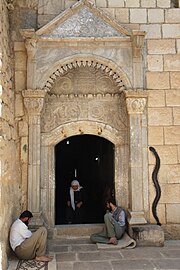야지디
이 문서의 일부는 오래된 정보를 가지고 있어 최신 정보로 교체하여야 합니다. 검토 후 최신 사건이 반영되도록 문서를 수정해 주세요. (2021년 1월) |
 | |
| 총 신자수 | |
|---|---|
| 100만 ~ 150만 명 (대략)[1][2] | |
| 종교 | |
| 과반수: 아지디교[3] 소수: 기독교 (아르메니아 사도교회와 복음주의, 아르메니아와 조지아 일부에서 채택),[4] 이슬람[5][6] | |
| 경전 | |
| Kitêba Cilwe Mishefa Reş | |
| 언어 | |
| 이란어,[7] 북메소포타미아 아랍어 (바시카와 바자니),[8] 아르메니아어 (아르메니아)[9] |

야지디(영어: Yazidis/Yezidis, 아랍어: إيزيدية, 아람어: ܐܝܙܝܕܝܐ, 튀르키예어: Yezidiler) 또는 예지디는 유럽어족[10][11][12]이면서 야지디교를 믿는 민족종교집단[13]이다. 야지디교는 조로아스터교와 옛 메소포타미아 종교들의 영향을 받았으나, 야지디인들은 독자적인 종교 커뮤니티와 그들의 문화를 가지고 있다.[14][15][16] 그들은 먼저 이라크의 니네베 평원에 살고 있으며, 그 외에 아르메니아, 조지아, 튀르키예, 이란, 시리아에 거주하며 1990년대 이후로는 유럽 특히 독일로 이주하고 있다.[17][18][19][20]
야지디교는 일신교이다.[21] 신이 이 세계의 창조자라고 믿으며, 일곱의 신성한 존재(천사)가 있다고 본다. 그 천사의 필두는 공작새로 묘사되는 멜렉 타우스이다.
2014년 8월부터 2017년까지 이라크 레반트 이슬람 국가(ISIL)는 야지디가 살고 있는 신자르 산맥를 공격하려고 하였고, 야지디를 박해하려고 시도하였다. 하지만 야지디족 군대는 미국 군대와 함께 ISIL을 격퇴하고 신자르 산맥에서 ISIL을 물리쳤다.[22]
신앙[편집]
그 신은 세계를 창조했으며, 세계를 보통 천사, 또는 heft sirr로 알려진 일곱 성스러운 존재의 손에 위임했다고 믿는다. 그 천사들의 수장은 '공작새 천사'인 "멜렉 타우스(Melek Taûs)"이다.[23][24]
야지디교의 경전은 Kitêba Cilwe(야지디 계시록)과 Mishefa Reş(야지디 흑서)이다.
위계[편집]
야지디 사회는 위계적이다. 세속의 지도자는 세습적인 에미르(또는 prince), 종교 지도자는 대(大) 셰이크(chief sheikh)이다. 야지디교도들은 엄격하게 야지디교도들과의 결혼만 허용되며 세 계층(murid, sheikh, pir)들은 그들 사이에서만 결혼한다. 2015년 현재 전세계 야지디교도의 에미르는 타흐신 사이드(Tahseen Said) 공이며,[25] 야지디교도의 종교 지도자인 바바 셰이크(Baba Sheikh)는 쿠르토 하지 이스마일(Khurto Hajji Ismail)이다.[26]
종교적 예식[편집]
기도[편집]

야지디교도들은 하루에 5번 기도한다.[27]
Nivêja berîspêdê (새벽 기도), Nivêja rojhilatinê (일출 기도), Nivêja nîvro (정오 기도), Nivêja êvarî (오후 기도), Nivêja rojavabûnê (일몰 기도)이다. 그러나, 대부분의 야지디교도들은 하루에 두 번, 일출과 일몰 기도만 드린다.
기도하는 사람들은 그들의 얼굴을 태양을 향하게 한다. 단, 정오 기도 때만은 얼굴이 성지(聖地) 랄리시(Lalish)를 향한다. 일상적인 기도는 이방인들 앞에서는 하지 않는다. 수요일이 성스러운 날이지만, 토요일이 휴일이다.[27][28]
성지순례[편집]

가장 중요한 의식은 매년 일주일간, 모술 북쪽의 랄리쉬에 있는 셰이크 아디 이븐 무사피르의 영묘를 순례하는 것이다.[27][29]
각주[편집]
- ↑ Lamb, Christina (2020년 9월 22일). 《Our Bodies, Their Battlefields: War Through the Lives of Women》 (영어). Simon and Schuster. 24쪽. ISBN 978-1-5011-9917-2.
- ↑ “Aziz Tamoyan blames unknown forces for crippling history and culture of Yazidis”. 《armenpress.am》 (영어). 2021년 1월 10일에 확인함.
- ↑ Arakelova, Victoria. “Ethno-Religious Communities Identity markers” (영어). Yerevan State University.
- ↑ “Population (urban, rural) by Ethnicity, Sex and Religious Belief” (PDF). 《Statistics of Armenia》. Statistics of Armenia. 2019년 5월 22일에 확인함.
- ↑ Nelida Fuccaro (1999). 《The Other Kurds: Yazidis in Colonial Iraq》. London & New York: I. B. Tauris. 9쪽. ISBN 1860641709.
- ↑ “Yazidis who suffered under Isis face forced conversion to Islam amid fresh persecution in Afrin”. 《The Independent》 (영어). 2018년 4월 18일. 2019년 9월 27일에 확인함.
- ↑ Dalalyan, Tork (January 2011). “Construction of Kurdish and Yezidi Identities among the Kurmanji-speaking Population of the Republic of Armenia, in”. 《Changing Identities: Armenia, Azerbaijan, Georgia (Collection of Selected Works, Edited by V. Voronkov, S. Khutsishvili, J. Horan), Heinrich Böll Stiftung South Caucasus》 (영어): 189.
- ↑ Allison, Christine (2004년 2월 20일). 〈Yazidis i: General〉. 《Encyclopædia Iranica》. 2010년 8월 20일에 확인함.
- ↑ “Population Census 2011 – Table 5.2-1 Population (urban, rural) by Ethnicity, Sex and Mother Tongue” (PDF). Statistics of Armenia. 2019년 5월 23일에 확인함.
- ↑ Iraklii CHIKHLADZE, Giga CHIKHLADZE THE YEZIDI KURDS AND ASSYRIANS OF GEORGIA: THE PROBLEM OF DIASPORAS AND INTEGRATION INTO CONTEMPORARY SOCIETY Archived 2015년 9월 23일 - 웨이백 머신; ca-c.org; accessed June 11, 2015.
- ↑ David Szakonyi Ethnic Mobilization in Post-Soviet Georgia: The Case of the Yezidi-Kurds Archived 2016년 8월 6일 - 웨이백 머신, ecmi.de; accessed June 11, 2015.
- ↑ Carole A.O'Leary THE KURDS OF IRAQ:RECENT HISTORY, FUTURE PROSPECTS Archived 2015년 9월 24일 - 웨이백 머신
- ↑ YAZIDIS i. GENERAL, iranicaonline.org; accessed June 11, 2015.
- ↑ Palmer, Michael D.; Burgess, Stanley M. (2012년 3월 12일). 《The Wiley-Blackwell Companion to Religion and Social Justice》. John Wiley & Sons. 405쪽. ISBN 9781444355369. 2014년 2월 25일에 확인함.
- ↑ “Background: the Yezidi”. The Guardian. 2007년 8월 15일. 2014년 8월 9일에 확인함.
- ↑ “Who, What, Why: Who are the Yazidis?”. BBC World News. 2014년 8월 8일에 확인함.
- ↑ Gezer, Özlem (2014년 10월 23일). “From Germany to Iraq: One Yazidi Family's War on Islamic State”. 《Der Spiegel》. 2015년 6월 24일에 확인함.
- ↑ Serinci, Deniz (2014년 5월 28일). “The Yezidis of Armenia Face Identity Crisis over Kurdish Ethnicity”. Rudaw Media Network.
- ↑ Green, Emma (2014년 8월 13일). “The Yazidis, a People Who Fled”. 《The Atlantic》.
Recently, Yazidis in Armenia tried to establish themselves as an independent, non-Kurdish ethnic group for political reasons...
- ↑ Krikorian, Onnik (2006년 11월 3일). “Armenia: Yezidi Identity Battle”. Institute for War and Peace Reporting.
- ↑ *The Religion of the Yezidis: Religious Texts of the Yezidis: Translation, Introd. and Notes, by Giuseppe Furlani, J.M. Unvala, 1940 -- "The religion of the Yezidis is monotheistic" pg. 3
- The Yezidis: The History of a Community, Culture and Religion, by Birgul Acikyildizm, I.B.Tauris, August 20, 2014 -- "...the monotheism of the Yezidis..." pg. 71
- Encyclopedia of the Peoples of Asia and Oceania, by Barbara A. West, Infobase Publishing, January 1, 2009 -- "...the ancient Yezidi religion (monotheist with elements of nature worship)..." p.53
- Religious Freedom in the World, by Paul A. Marshall, Rowman & Littlefield, 2000 -- "The Ezidi ("Yezidi") religion, a monotheistic faith..." p. 212
- ↑ “Who Are the Yazidi, and Why Is ISIS Targeting Them?”. 2015년 7월 3일에 확인함.
- ↑ Asher-Schapiro, Avi (2014년 8월 11일). “Who Are the Yazidis, the Ancient, Persecuted Religious Minority Struggling to Survive in Iraq?”. 《National Geographic》. 2015년 6월 24일에 확인함.
- ↑ Thomas, Sean (2007년 8월 19일). “The Devil worshippers of Iraq”. 《The Daily Telegraph》. 2015년 6월 24일에 확인함.
- ↑ “Assyrian International Newsagency (AINA), ''Iraqi Yazidi MP: We Are Being Butchered Under the Banner of 'There is No God But Allah'”. AINA. 2014년 8월 18일에 확인함.
- ↑ Salih, "Islamic Extremists Pose New Risks for Religious Minorities in Iraq", New York Times, 24 June 2014.
- ↑ 가 나 다 “Yezidi Religious Tradition”. 《The Truth about the Yezidis》. YezidiTruth.org. 2017년 10월 10일에 원본 문서에서 보존된 문서. 2015년 12월 10일에 확인함.
- ↑ MacFarquhar, Neill (2003년 1월 3일). “Bashiqa Journal: A Sect Shuns Lettuce and Gives the Devil His Due”. 《The New York Times》. 2008년 3월 31일에 확인함.
Yazidis pray three times a day, at dawn, midday and sunset, facing the direction of the sun each time. 'The sun is very holy to us,' said Walid Abu Khudur, the stocky, bearded guardian of the temple built in honor of a holy man here. 'It is like the eye of God, so we pray toward it.'... They have adopted Christian rituals like baptism and a smattering of practices from Islam ranging from circumcision to removal of their shoes inside their temples. The importance of fire as a divine manifestation comes from Zoroastrianism, the ancient Iranian faith that forms the core of Yazidi beliefs. Indeed their very name is likely taken from an old Persian word for angel.
- ↑ Hedges, Chris (1993년 5월 31일). “Sheik Adi Journal: Satan's Alive and Well, but the Sect May Be Dying”. 《The New York Times》. 2007년 7월 21일에 확인함.
The Yazidis, who are part of Iraq's Yazidi minority, had 100 of 150 villages demolished during the counterinsurgency operation against the Kurdish rebel movement that reached its peak in 1988. The campaign, which moved hundreds of thousands of people to collective villages, saw 4,000 Yazidi villages dynamited into rubble. ... The sect follows the teachings of Sheik Adi, a holy man who died in 1162, and whose crypt lies in the shrine in the Lalish Valley, about 15 miles east of Mosul. The shrine's graceful, fluted spires poke above the trees and dominate the fertile valley. ... Like Zoroastrians they venerate fire, the sun and the mulberry tree. They believe in the transmigration of souls, often into animals. The sect does not accept converts and banishes anyone who marries outside the faith. Yazidis are forbidden to disclose most of their rituals and beliefs to nonbelievers.
